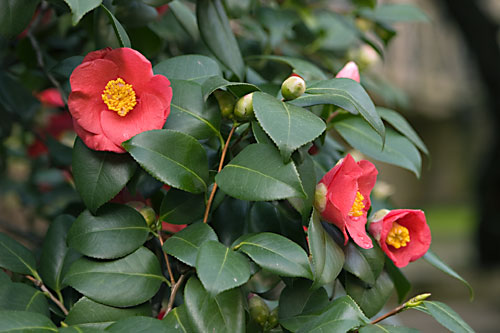
|

|
Posted: January 23
(Rome) For the past two weeks Rome has been unseasonably mild, as has most of Europe. Many of the European members of our community assume that the whole world is as warm as what they are experiencing. But then I talk to family back in Colorado who are enduring one of the coldest and snowiest winters in recent memory. Avalanches up on Berthoud Pass closed the highway and a storm on the plains shut down the airport. So the weather is strange indeed, but not the same everywhere.
If we have a hard time understanding such phenomena, the plants in our garden can easily be forgiven their confusion. Some of the iris' have already bloomed and the narcissus' have come and gone, long before spring is anywhere in sight. Only the camellia trees are blooming on schedule. There were two in our garden when I arrived in the Curia, and we have planted four more to have a symmetrical arrangement. I like the intense red color of their flowers that plays off against the cool grey-green of the leaves. And I like the fact that this plant is named in honor of an early Jesuit botanist, Georg Josef Kamel SJ.

Georg Josef Kamel was born in 1661 in Brno, Moravia (which is now the Czech Republic). When he joined the Jesuits as a brother, he began spelling his name in its Latin form, "Camellus." He was sent first to the Marianas in 1683 and then to the Philippines in 1688 where he began to study botany and served as infirmarian and pharmacist. Kamel established a pharmacy in Manila--the first in the Philippines--where poor people could get remedies for free. He became the first plant specialist of the Philippine Islands and discovered the medicinal properties of a plant he named "St. Ignatius Bean" (Strychnos ignatii), which is known today as strychnine. His reports on the plants and natural history of the islands were published in London in “The Philosophical Transactions of the Royal Society.” Charles von Linnaeus, the Swedish botanist responsible for creating the system of taxonomy, was so impressed with Kamel's work that he decided to honor Kamel by renaming Thea sinensis “Camellia sinensis.” Even though Georg Kamel did not discover the plants we now know as Camellias, their name honors his pioneering investigations. He is thought by many to be the most significant pharmacist of the 17th century, and UNESCO named the 300th anniversary of his death in 2006 as an important anniversary for the world.
These reflections on Brother Kamel lead me to wonder how his tradition of scientific inquiry that combined with care for the poor is continuing today. We Jesuits are preparing for the 35th general congregation in our order's history; it will begin next January but has already caused us to reflect on the issues that we must face as a religious order. Not surprisingly, environmental concerns are coming forward in a way they never did before. The negative impact of human behavior on the environment is an issue that we must consider as citizens of this globe. Part of the answer is political change, since reducing greenhouse gases, just to take one example, requires industrial and transportation changes that have a political impact. Creativity and discovery of new energy sources and new technology that has less negative impact is another answer. Pioneers like George Josef Kamel inspire us to be as studious as he was four hundred years ago.
back to previous entries